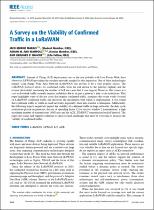JavaScript is disabled for your browser. Some features of this site may not work without it.
- ResearchSpace
- →
- Research Publications/Outputs
- →
- Journal Articles
- →
- View Item
| dc.contributor.author |
Marais, JM

|
|
| dc.contributor.author |
Abu-Mahfouz, Adnan MI

|
|
| dc.contributor.author |
Hancke, GP

|
|
| dc.date.accessioned | 2020-10-05T09:18:08Z | |
| dc.date.available | 2020-10-05T09:18:08Z | |
| dc.date.issued | 2020-01 | |
| dc.identifier.citation | Marais, J.M., Abu-Mahfouz, A.M.I. and Hancke, G.P. 2020. A survey on the viability of confirmed traffic in a LoRaWAN. IEEE Access, v8, pp 9296-9311. | en_US |
| dc.identifier.issn | 2169-3536 | |
| dc.identifier.uri | https://ieeexplore.ieee.org/document/8952708/ | |
| dc.identifier.uri | DOI: 10.1109/ACCESS.2020.2964909 | |
| dc.identifier.uri | http://hdl.handle.net/10204/11603 | |
| dc.description | This work is licensed under a Creative Commons Attribution 4.0 License. | en_US |
| dc.description.abstract | Internet of Things (IoT) deployments are on the rise globally with Low Power Wide Area Networks (LPWAN) providing the wireless networks needed for this expansion. One of these technologies namely Long Range Wide Area Network (LoRaWAN) has proven to be a very popular choice. The LoRaWAN protocol allows for confirmed traffic from the end device to the gateway (uplink) and the reverse (downlink), increasing the number of IoT use cases that it can support. However, this comes at a cost as downlink traffic severely impacts scalability due to in part a gateway’s duty cycle restrictions. This paper highlights some of the use cases that require confirmed traffic, examines the recent works focused on LoRaWAN confirmed traffic and discusses the mechanism with which is implemented. It was found that confirmed traffic is viable in small networks, especially when data transfer is infrequent. Additionally, the following aspects negatively impact the viability of confirmed traffic in large networks: the duty cycle restrictions placed on gateways, the use of spreading factor 12 for receive window 2 transmissions, a high maximum number of transmissions (NbTrans) and the ACK_TIMEOUT transmission backoff interval. The paper also raises and suggests solutions to open research challenges that must be overcome to increase the viability of confirmed traffic. | en_US |
| dc.language.iso | en | en_US |
| dc.publisher | IEEE | en_US |
| dc.relation.ispartofseries | Worklist;23671 | |
| dc.subject | Low Power Wide Area Networks | en_US |
| dc.subject | Long Range Wide Area Network | en_US |
| dc.subject | LoRaWAN | en_US |
| dc.subject | Internet of Things | en_US |
| dc.subject | IoT | en_US |
| dc.title | A survey on the viability of confirmed traffic in a LoRaWAN | en_US |
| dc.type | Article | en_US |
| dc.identifier.apacitation | Marais, J., Abu-Mahfouz, A. M., & Hancke, G. (2020). A survey on the viability of confirmed traffic in a LoRaWAN. http://hdl.handle.net/10204/11603 | en_ZA |
| dc.identifier.chicagocitation | Marais, JM, Adnan MI Abu-Mahfouz, and GP Hancke "A survey on the viability of confirmed traffic in a LoRaWAN." (2020) http://hdl.handle.net/10204/11603 | en_ZA |
| dc.identifier.vancouvercitation | Marais J, Abu-Mahfouz AM, Hancke G. A survey on the viability of confirmed traffic in a LoRaWAN. 2020; http://hdl.handle.net/10204/11603. | en_ZA |
| dc.identifier.ris | TY - Article AU - Marais, JM AU - Abu-Mahfouz, Adnan MI AU - Hancke, GP AB - Internet of Things (IoT) deployments are on the rise globally with Low Power Wide Area Networks (LPWAN) providing the wireless networks needed for this expansion. One of these technologies namely Long Range Wide Area Network (LoRaWAN) has proven to be a very popular choice. The LoRaWAN protocol allows for confirmed traffic from the end device to the gateway (uplink) and the reverse (downlink), increasing the number of IoT use cases that it can support. However, this comes at a cost as downlink traffic severely impacts scalability due to in part a gateway’s duty cycle restrictions. This paper highlights some of the use cases that require confirmed traffic, examines the recent works focused on LoRaWAN confirmed traffic and discusses the mechanism with which is implemented. It was found that confirmed traffic is viable in small networks, especially when data transfer is infrequent. Additionally, the following aspects negatively impact the viability of confirmed traffic in large networks: the duty cycle restrictions placed on gateways, the use of spreading factor 12 for receive window 2 transmissions, a high maximum number of transmissions (NbTrans) and the ACK_TIMEOUT transmission backoff interval. The paper also raises and suggests solutions to open research challenges that must be overcome to increase the viability of confirmed traffic. DA - 2020-01 DB - ResearchSpace DP - CSIR KW - Low Power Wide Area Networks KW - Long Range Wide Area Network KW - LoRaWAN KW - Internet of Things KW - IoT LK - https://researchspace.csir.co.za PY - 2020 SM - 2169-3536 T1 - A survey on the viability of confirmed traffic in a LoRaWAN TI - A survey on the viability of confirmed traffic in a LoRaWAN UR - http://hdl.handle.net/10204/11603 ER - | en_ZA |






